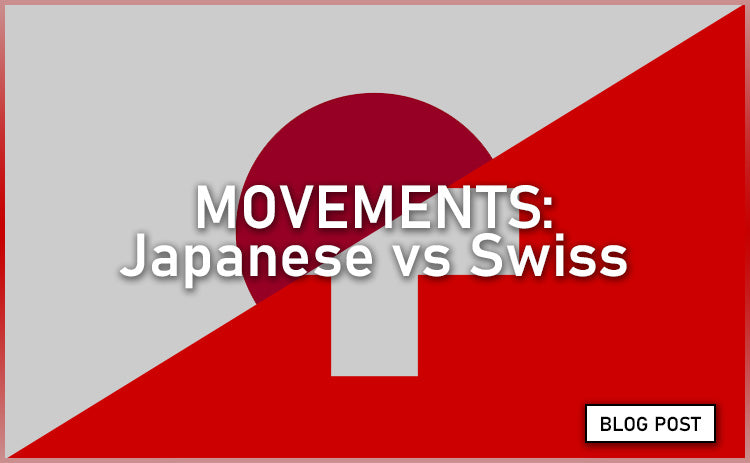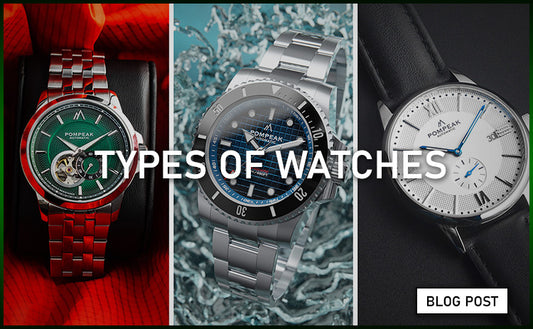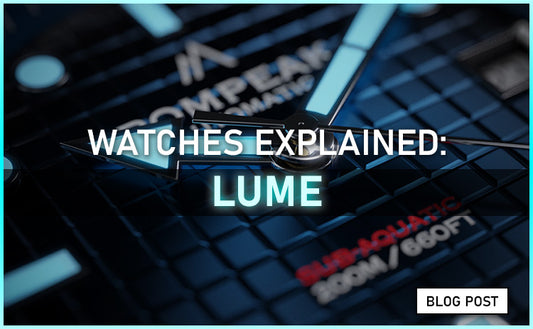
Japanese vs Swiss Movements
Share

What actually is a watch movement?

Calendar & chronograph complications seen on Pompeaks debut collection
These movements fall into two categories; Quartz and Mechanical.
|
Quartz watches are battery powered and regulated by the vibrations of a quartz crystal. The first wrist watch to use such technology was released in 1969 - the Seiko Astron.
Fast forward to today and you'll find quartz movements are used in around 90% of the world’s watches due to their incredible reliability, accuracy and relatively low cost.
With this technology being first introduced in Japan, the Swiss and other manufacturers have been playing catch up ever since.
|
 |

Japanese Movements:
 Miyota 82S5 Automatic Movement (Japan)
|
Japanese manufacturers are known for their perfectionism, and the same is true for their watch movements. Whether quartz or mechanical, they will be produced with extreme quality, accuracy and reliability. From springs to cogs, even lubricants and oils, all parts will likely be made in Japan, with industry leading technology and often on automated production line with a very high degree of precision.
-
The automated method of manufacture often leads to cheaper movements than Swiss counterparts, but does not in any way stipulate lower quality (in fact the opposite is often true).
|
Swiss Movements:
|
Swiss movements have a heritage of craftsmanship and it’s no secret that Swiss movements are found in very high ticket watches. Priding on aesthetics, every detail is thought through, from the way the metals are cut and finished, to the placement of the jewels. These movements are assembled in Switzerland, often by hand and often using components produced externally - in China or Thailand for example. Whilst this may come as a shock to those newer to the world of watches, this is not a mark against quality. Swiss assemblies have very stringent control checks - But yes, the Swiss movement you’re paying a premium for may in fact only be 60% Swiss. |
Omega (Swiss) Movement
|
So what’s the difference?
The time and skill required in hand assembly of tiny watch components is undoubtedly impressive and the Swiss horology heritage has been earned through generations of world class craftsmanship.
This does come at a cost however and Swiss watches will generally carry a much higher price tag.
In contrast, Japanese movements will use similar materials, assembled with great precision on incredible automated lines at much lower price point.
Which is better? Well that is a matter of perspective.
If you are happy to pay a premium for the heritage and the incredible passion for perfection right down to the most minute aesthetic details then Swiss may be the choice for you.
If however, you're looking for a great quality functional and reliable movement at a more reasonable price then Japanese may suit you.
(Note: there are always exceptions to any rule, so whatever you decide, make sure you go with the watch that feels right to you)
So what do we chose?
At Pompeak, our mission is to create the watches we want to wear and introduce them at an affordable price point, so for us, right now, we are using some fantastic Japanese movements that allow us to produce stunning watches that deliver on both quality and cost. That is not to say we won't be including Swiss movements in future releases.
I have tried to be as on the fence as possible with this post as both Swiss and Japanese movements can be found in beautiful watches that, if treated correctly, will outlive there owners. So if you're searching for your new watch, follow your heart and you won't go far wrong.
Thanks for reading.
Be sure to check out other blogs for more.
Noah
Co-founder
www.pompeak.com




